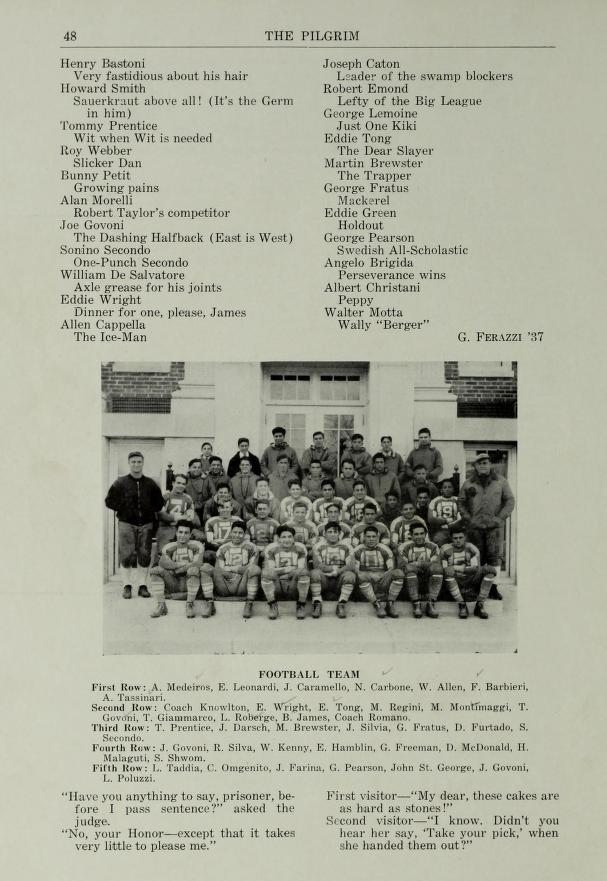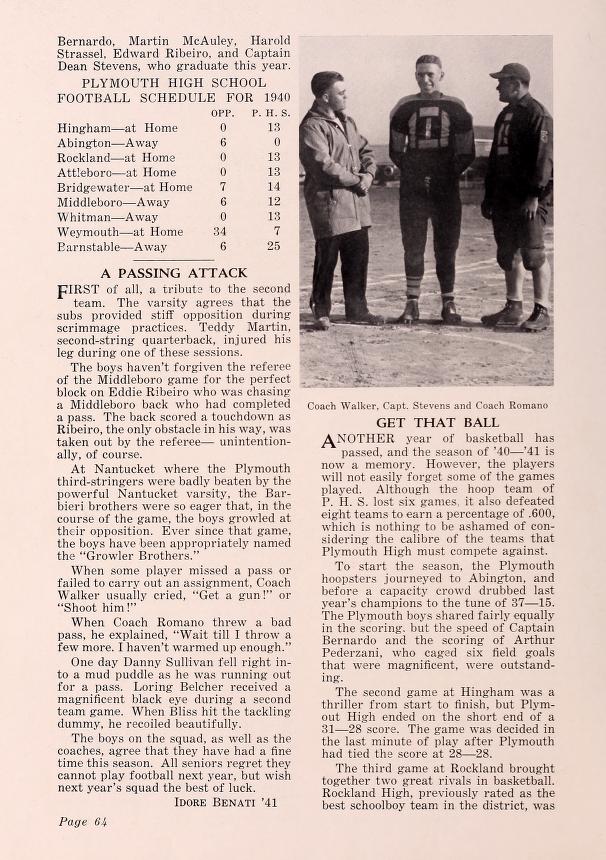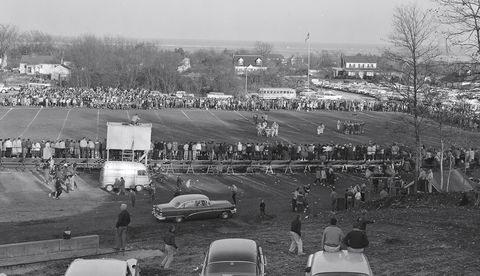Thanksgiving time is upon us and there is no better place to celebrate than Plymouth, the birthplace of the holiday. Thanksgiving Day in Plymouth is packed with events and happenings. They range from the morning march of Pilgrims Progress to the National Day of Mourning sponsored by the indigenous tribes of North America.
Plimoth Pawtuxet Museums offers Thanksgiving meals throughout the day, local churches often have services, and the town is filled with visitors. It’s a day filled with overstuffed meals celebrated with family and friends, or remembrance feasts mourning the loss of a way of life.
Oh, and one more thing: For the last 65 years Thanksgiving has also meant an annual high school football clash here in town. When did football enter the scene in Plymouth and when did Thanksgiving become the end of the season game? It’s a story worth recounting.
The game of football was introduced to Plymouth in 1886 when a local boy obtained the rule book and organized a team. Playing without a coach, the team made its home field the Lincoln Street playground and dressed in heavy oil skin coats and whatever footwear was available. The team played against boys from Kingston, Bridgewater, and the Powder Point Academy in Duxbury. They traveled to away games in horse and cart; a trip to Duxbury could take three hours. Early fall became the season of the new sport.
The next time football in Plymouth pops up in history is with a citation in “Plymouth Memories of an Octogenarian” by William T. Davis, which was published in 1906, shortly before his death. He mentions football played by local neighborhood “gangs” (neighborhood-centric kids) when autumn arrived. His “North Street Gang” played on the Jackson Field on North Street. Davis vividly describes the football itself as “made of an ox bladder inserted in a leather case of our own making. We bought the bladder at the slaughterhouse, and put it in pickle until it was ready to be used, and then when the case was made we put it through a slit, and blowing it up with a quill tied a string around the nozzle, laced up the slit, and the game began. In those days all the boys wore boots, and consequently little damage was done to our shins.”

It is uncertain when football became a sanctioned high school sport, but it is briefly mentioned in the 1925 Pilgrim yearbook. The citation only mentions the seniors’ last game, played on the Military Training Green on Sandwich Street.
As a side note, most of the information in this article was gleaned from school yearbooks. The first yearbook published under the Pilgrim name was in 1921. The Pilgrim was published four times throughout the school year, with the June issue featuring the graduating seniors and a recap of their last year in high school. The Plymouth Public Library features a digital archive of the yearbooks from 1930 to 2016, and contains more recent volumes up to the present day.
In 1930, football received little more than a single paragraph, even though the yearbook notes that the team was crowned South Shore champions for the second consecutive year. It’s a stark contrast to the baseball, basketball, and track teams, which are glorified with bigger write-ups. The team won the championship for a third time in 1931. The football players finally received a team photo in 1933, but not again until 1937 (my absolute favorite yearbook cover of all time). Team photos were then regularly published in subsequent issues.
Throughout the rest of the decade, Plymouth played against various teams, including from Kingston, Rockland, Hingham, Weymouth, as well as towns further away like Saugus and Dedham.
In the 1940s, we see the first indication of a rivalry. The 1940 yearbook mentions the 45th annual classic game between Plymouth and Whitman, giving us the clue that high school football had been played as early as 1895. Whitman won the day that year with a 7-6 victory over Plymouth. Despite the war years (from 1943 to 1945 the yearbook was called “Till Victory”), football continued to be played, becoming the most prominent sport featured in the yearbook by the end of the decade.
During the 1950s, the Plymouth football team generally played a 7-game season, with a roster of 30 players. Towns in the league included Rockland, Bridgewater, Middleborough, Abington, Hingham, Stoughton, and a mid-season game against rival Whitman. Games were first played at Stephens Field, a short walk from the high school, then located on Lincoln Street, before switching to Siever Field in North Plymouth. Meanwhile, the rivalry with Whitman faded with the rise of competition with Silver Lake Regional High School, which drew students from Kingston, Pembroke, Halifax, and Plympton, and, for a brief time, Carver. Games in November were often played on snow covered fields and in 1958 the first Thanksgiving game was played, beginning a tradition that has now continued for 66 years.
In 1963, the towns of Plymouth and Carver formed a regional school district and built a new school on Obery Street. The 1963 game against Silver Lake was played at Siever Field before a record crowd of 6,000 fans. It wasn’t until 1965 that the playing field at the new high school was ready. (The field was later dedicated to former football coach Mario Romano.) The Plymouth-Carver/Silver Lake rivalry continued until 1988 when the last team would be fielded by Plymouth Carver.

At the end of the decade, in response to strong growth in population that led Plymouth to divorce from Carver, the teams played as a united team for the last time. Perhaps the 1989 game was an omen: a major blizzard buried Plymouth with more than 10 inches of snow on Thanksgiving Day. The game was postponed and played the following Saturday. Plymouth Carver was victorious, securing a spot in the State Super Bowl tournament, where the team won the state division crown. From 1990 through 1993 Plymouth North and Plymouth South played as a united team, finally fielding their own teams during the 1994 season.
On Thanksgiving in 1994 and 1995, Plymouth South faced traditional rival Silver Lake, while Plymouth North played Dennis Yarmouth.
In 1996, the two schools (who had played against each in 1994 and 1995 on a different date) finally met on the football field on Thanksgiving Day.
How much of a cross-town rivalry this is, is debatable. The geographic line dividing North and South is not rigid. Depending on the circumstances, Plymouth students can attend the high school in the opposite district, siblings often attend different schools, and kids who live next door to each other can find themselves in a high school without their neighborhood friends.
In my neighborhood, the “gang” that grew up together attended four different high schools. One attended North (which was my neighborhood’s district). Two attended Notre Dame, one went to Sacred Heart, and my daughter participated in the vocational program at Plymouth South. In addition, both schools share a marching band, and the coaches of both teams gather after the game to celebrate the season. Rivalry? Maybe more of a homecoming for Plymouth residents to support our kids regardless of which team they are on.
So who do I root for? My own high school (building and district) no longer exists because I attended Plymouth-Carver. I live in the North district. On the flip side, my daughter attended Plymouth South and now she and my brother are both on the staff there (teacher and vice principal respectively).
My loyalties are decidedly split, a problem I’m happy to live with in a town with two amazing high schools.
I had some research help with this column. Big thanks to the Plymouth Public Library and Julie Burrey; Scott Fry, the Plymouth South athletic director; and Carl Freyermuth, the former Plymouth-Carver football coach, who won the state Super Bowl championship twice. Best wishes to North and South this Thanksgiving. The game kicks off at 10 a.m. at the Plymouth South field.
Architect Bill Fornaciari is a lifelong resident of Plymouth (except for a three-year adventure going West as a young man) and is the owner of BF Architects in Plymouth. His firm specializes in residential work and historic preservation. Have a question or idea for this column? Email Bill at billfornaciari@gmail.com.

